Frequently Asked Questions
There never is a good time for a septic backup, but with proper planning and education to handle the situation when it arises, you can avoid having the system back up into your house and damage your property or ruin an event. We would be happy to answer your questions any time!
For a detailed view of the components of your septic system, or to identify your septic system click on the following links:
| Healthy Gravity | Unhealthy Gravity |
| Healthy Pump | Unhealthy Pump |
| Healthy Mound | Healthy Sand-Lined Bed |
| Healthy Sand Filter | System with an ATU and Drip Drainfield |
Unhealthy Gravity Septic System
If used properly, a septic system should need pumping about every 3 years, although it should be checked about once a year. There are however several factors that can decrease or increase the amount of time between pumpings. If a house is occupied by more people than the system was designed for, or if items and fluids which a septic system is not able to process are introduced into the system, then it may need to be pumped more frequently. If a house is occupied by less people than the system was designed for, or the house is not occupied full time, then you may need to get your system pumped far less frequently. In any case, it is difficult to be sure unless you look, so if you have any concerns, do not hesitate to have someone check it.
The alarm means that there is a high level of fluids in the pump chamber of your septic system, or that an electrical issue is affecting pump and/or float function. This may be caused by the pump failing, component failure, or by an electrical problem. Frequently when there is a power outage and the system is used normally, when the power comes back on the alarm goes off because the pump was not working during the outage. Either way, if the alarm goes off, a household should take immediate action to reduce their water usage, shorter showers and refrain from doing dishes or laundry until someone comes out to figure out what the problem is.
When your septic system has a pump, there typically is an alarm box to let you know if there is a problem. While these alarms are certainly important, it is Murphy's law that they always seem to go off in the middle of the night. And they are loud. On purpose.
For middle of the night emergencies, your go-to will be to silence the alarm. This is perfectly fine but realize that if an alarm is repeatedly going off during the nighttime hours when everyone is asleep, it's probably due to a toilet overrunning the system. This will happen if there is mineral build up on the flange, or if the handle gets hung up.
For an alarm that goes off, gets silenced and then stays on, you need to make sure and follow up! We have seen many sleepy homeowners turn off the alarm in the middle of the night then totally forget to check back and make sure the alarm reset. We commonly see a forgotten (but silenced!) alarm that causes catastrophic damage, especially when plumbing fixtures are in a lower level of the home that is not used as frequently.
For peace of mind, if you have a pump on your system check your panel(s). Get familiar with their location and go ahead and toggle that switch so you know what it sounds like. If you don't know what you're dealing with, feel free to send us a text or email with a picture and we will walk you through it!
Alarm box in garage: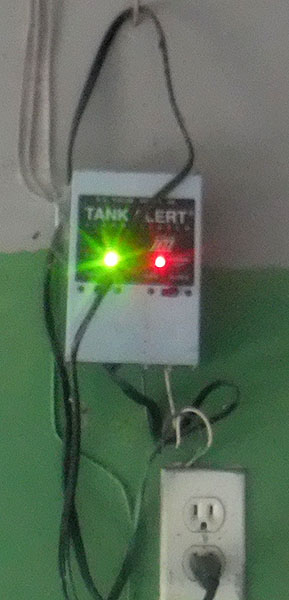
DF50 Alarm box unwired: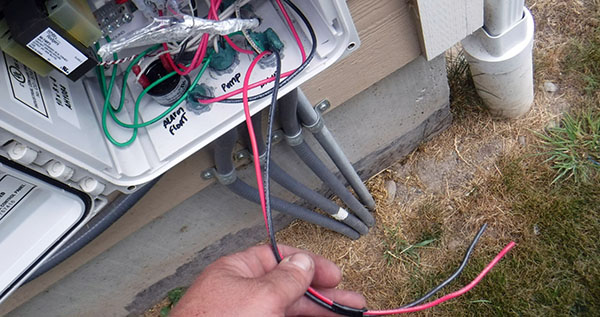
Panel functioning after alarm restored: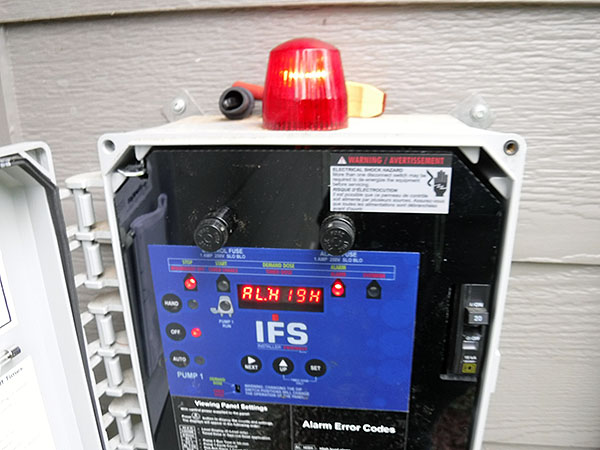
Pump alarm silenced: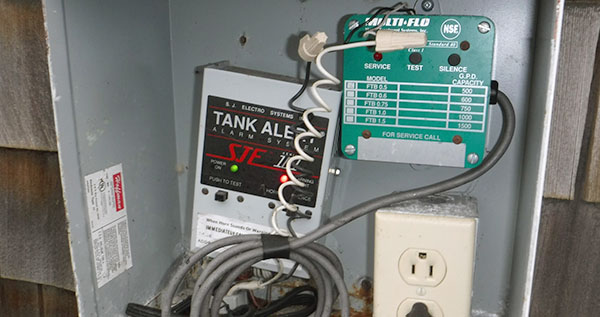
Rusted & shorted out alarm box: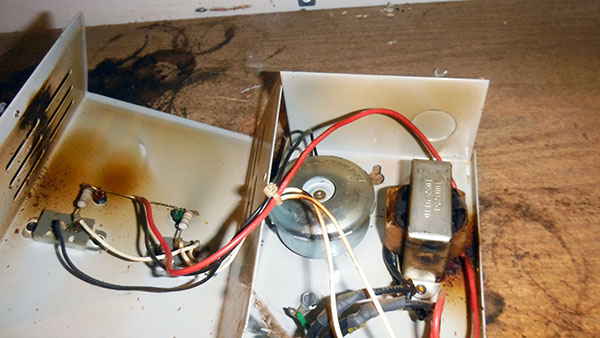
As a general rule, the only things other than toilet paper that should go into your septic system, are things that have been passed through your body. Toxic chemicals, such as toilet bowl cleaners and paint thinners should not be flushed as they will kill off the bacteria necessary for the break down of the solids. If the house has a garbage disposal, its use should be minimal, if at all. Grease from cooking will eventually solidify and block the inlet into the tank, causing a backup into the house. Any sort of feminine hygiene products, condoms, or flushable wipes should not be flushed down the toilet, just because an object can be flushed, does not mean it can be processed by a septic system.
While these products most likely will not harm your system, they have not been proven by the state to be beneficial, and so we can not sell or encourage the use of these products.
There are many problems which may result in a backup. The line from the house to the septic system may be plugged or crushed. The filter in the septic tank may be clogged so badly that the liquids can no longer leave the tank. If there is a pump, it may have burned out, not allowing the liquids to go out to the drainfield. The drainfield itself may have failed, not allowing the liquids to be released into the soil. Any one of the issues requires a licensed technician to come out and identify and repair the problem.
Ground cover plants such as kinnikinnick and salal are ideal for planting on drainfields, as their roots give the soil structure, but do not extend deep enough to damage the underground piping. Larger plants such as trees and shrubs should not be used, as the deep penetrating roots can grow into the drainfield pipes, blocking the flow, and can also rip out the drainfield if they are ever knocked over in a windstorm. Large plants should only be planted a safe distance away from the drainfield, at least 20 feet. Plants for food production should never be planted on or near a drainfield, as the risk of the plant retransmitting a disease with the food, however remote, is always possible, and not something you want to gamble on.
There are relatively few things in a septic system that can cause irreparable damage system, and most involve the drainfield. If the baffle falls off, solids can leave the tank before they have been sufficiently broken down, and will plug the emitter holes in the piping of the drainfield. Driving vehicles on the drainfield can crush the pipes or compact the soil, not allowing the fluids to flow. Using excessive water for long periods or not having your system serviced frequently enough can cause solids to flow into the drainfield before they have been sufficiently broken down. Inside the tank, failure can occur if toxic chemicals or introduced, killing the bacteria necessary to break down the sewage.
One of the more important components you can choose to have installed is a baffle filter. This screened pipe is placed in the outlet of your septic tank, prior to the effluent traveling to your drainfield or pump chamber. The investment is well worth while to protect these more expensive parts of your septic system. The filter will prevent long term issues, but needs to be maintained in order to not cause backing up into the house.
 A baffle filter is like the air filter in your car. It needs to be cleaned to allow the effluent to pass to the next component, and gets clogged up, just like any normal filter with normal usage. In order to access the filter, you will need to open up that side of your septic tank. If you have risers to grade, you're set! All you need is to open the lid. If your outlet is not risered to grade, you will need to dig up that side of the tank, or call us to open it up for you.
A baffle filter is like the air filter in your car. It needs to be cleaned to allow the effluent to pass to the next component, and gets clogged up, just like any normal filter with normal usage. In order to access the filter, you will need to open up that side of your septic tank. If you have risers to grade, you're set! All you need is to open the lid. If your outlet is not risered to grade, you will need to dig up that side of the tank, or call us to open it up for you.
Step One: You will need a hose, drill/allen wrench, and a wire coat hanger or hook to pull the filter out of the baffle. We also strongly recommend using gloves- either disposable or garden, just plan on washing them afterwards.
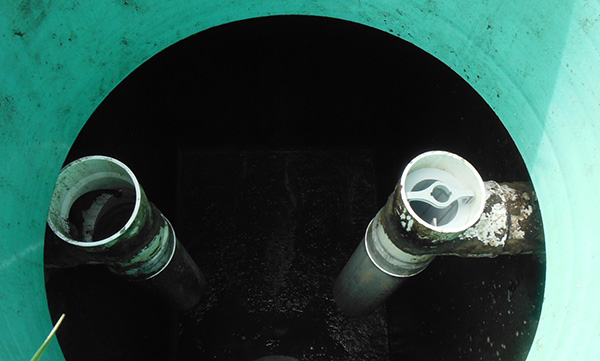 Step Two: Unscrew the riser lid (or remove if not screwed down/lift out if it is concrete). If you have the right access point, it should look like this from the top down viewpoint. Make sure and keep the screws with the lids, as standard deck or drywall screws do not secure properly into the riser and are typically not stainless steel in order to prevent rusting. If you have a slip-style cap (on an 8" riser opening), all you have to do is pull the cap up.
Step Two: Unscrew the riser lid (or remove if not screwed down/lift out if it is concrete). If you have the right access point, it should look like this from the top down viewpoint. Make sure and keep the screws with the lids, as standard deck or drywall screws do not secure properly into the riser and are typically not stainless steel in order to prevent rusting. If you have a slip-style cap (on an 8" riser opening), all you have to do is pull the cap up.
Step Three: Using a wire coat hanger or hook, latch onto the top crossbar or handle. Pull the filter out most of the way from the baffle itself, leaving the bottom couple of inches in the baffle. If, for whatever reason, the pipe feels loose or unstable, call us to evaluate the situation for no charge.
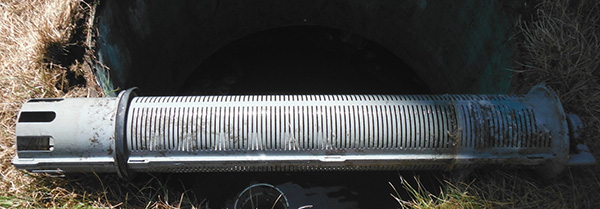 Step Four: Using pressurized water from the hose, rinse the filter so that all of the media/filter surfaces are clear again, and allowing the solids & dirty water to flow back into the tank.
Step Four: Using pressurized water from the hose, rinse the filter so that all of the media/filter surfaces are clear again, and allowing the solids & dirty water to flow back into the tank.
As septic systems are upgraded, changed & replaced, one item we run into repeatedly is why a customer would choose to have risers installed for access to their septic and/or pump tanks on their system. Access to grade became code in 2006, and is part of a standard installation now. Risers allow ongoing maintenance and inspection of your septic system without having to disturb the grass and/or landscaping in the area.
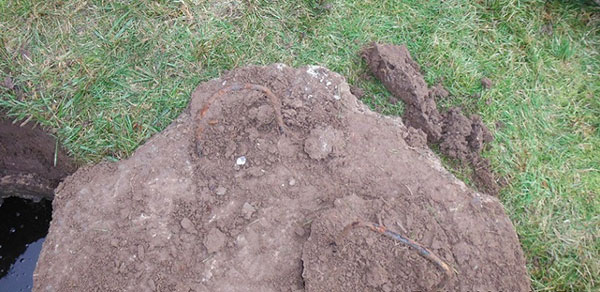 Additionally, there are times when it is just downright inconvenient to have to dig up your septic system. For example, Black Friday morning, after Aunt Marge put the rest of the turkey down the sink using the garbage disposal on Thanksgiving night. The last thing you want when you have an entire household of guests is to have a septic problem, and by having risers installed the problem can be addressed much more quickly, with less disruption to you or your guests.
Additionally, there are times when it is just downright inconvenient to have to dig up your septic system. For example, Black Friday morning, after Aunt Marge put the rest of the turkey down the sink using the garbage disposal on Thanksgiving night. The last thing you want when you have an entire household of guests is to have a septic problem, and by having risers installed the problem can be addressed much more quickly, with less disruption to you or your guests.
Another point- concrete lids set into the tops of tanks begin to break down and fall apart after many years of use. These lids can become unstable, as well as allowing water and dirt into the tank. In extreme situations, this water intrusion can actually prematurely fail your septic system. When we have large rain events (like almost every November), hundreds of gallons can be going into your tank and you dont even realize you have a problem. Installing risers is a pricey proposition, but has its benefits. In order to install risers, we dig down to the top of the tank(s), clearing the dirt away from the opening to the tank(s) themselves. Once there, we can get a clear measurement as to how tall the riser pipe needs to be installed. Some customers choose to have the risers installed just below the level of the grass (if planted in that area), and others have bark or gravel beds, and want the ability to cover the green lids with those materials. Just let us know what works for you, and we will make it happen!
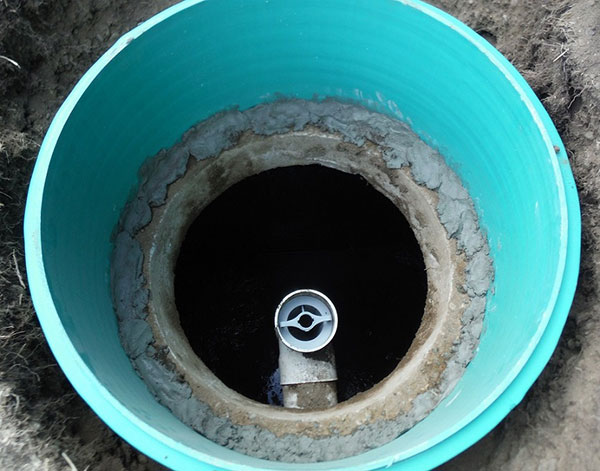 After the pipe is cut, the risers are bedded to the top of the tank in mortar mix. Depending on the depth of the pipe installed, this mortar serves to prevent water intrusion, but also provides stability as the pipe is backfilled. Once the pipe is secured, the site is backfilled and a properly sealing lid is placed on top. If the lid is larger than 8", it is screwed down for safety purposes. We will leave the allen wrench that fits those screws with you at the time that we come out (If you need a replacement later, just ask; we're more than happy to send one to you J). We always screw down all lids, period. Given the number of children that have been hurt by unsecured septic & pump tank lids, we are simply not willing to risk anyone's safety.
After the pipe is cut, the risers are bedded to the top of the tank in mortar mix. Depending on the depth of the pipe installed, this mortar serves to prevent water intrusion, but also provides stability as the pipe is backfilled. Once the pipe is secured, the site is backfilled and a properly sealing lid is placed on top. If the lid is larger than 8", it is screwed down for safety purposes. We will leave the allen wrench that fits those screws with you at the time that we come out (If you need a replacement later, just ask; we're more than happy to send one to you J). We always screw down all lids, period. Given the number of children that have been hurt by unsecured septic & pump tank lids, we are simply not willing to risk anyone's safety.
Riser installation is also strongly advised when you have a baffle filter installed in the outlet of your tank for ongoing access for cleaning. If you are going to be opening up your tank every six months to clean your filter, you certainly don't want to dig it up each time. One other thing to consider as you look forward to spring landscaping projects is how your landscaping is affected by your septic system. In extreme situations like the pictures below, the customer had extensive landscaping work done, not realizing the ongoing issues of accessing and maintaining their septic system. A trackhoe had to be brought in to make it possible to install risers for ongoing access.
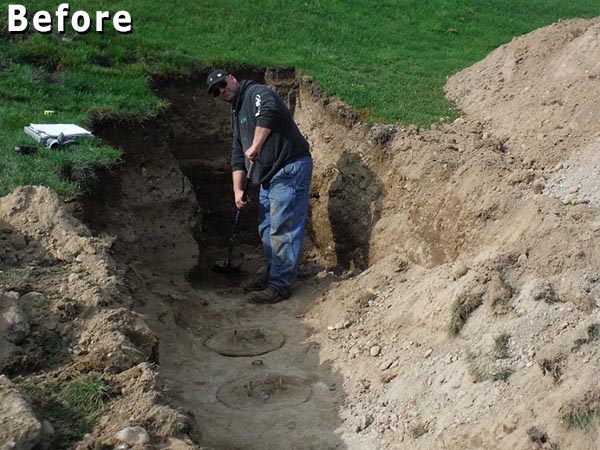
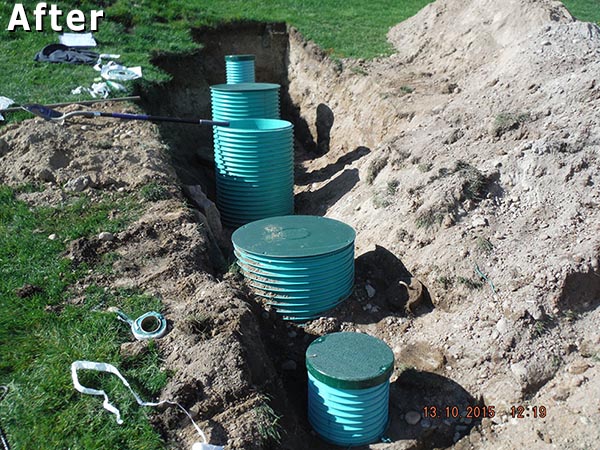
If you need help or advice, please feel free to call, text, or email us anytime. We're happy to help!
Buying a house is the most expensive investment you will make in your lifetime, and the septic system at the property you are buying can make or break your investment. If you don't catch problems during your inspection process, you could end up facing tens of thousands of dollars to replace it, as well as the time to complete the work. Taking a few extra minutes to understand what you have in the ground and how you can extend the life of your system is certainly worth a few hundred dollars before you seal the deal. In 2007, Washington State changed the laws regarding septic systems and their maintenance. This was partly due to extreme algae blooms in the local rivers and Hood Canal, but also due to thousands of new homeowners being stuck with a bill after purchasing a house. Every county has slightly different laws, but, for the most part, the rules are: for gravity systems, have the system checked every three years, and pumped as needed. For systems involving pumps or alternative treatment components, the system should be checked once a year. Pumping should be done when the scum and solid levels at the inlet of the tank are 1/3 of the tank capacity.
That being said, just having the tank(s) pumped certainly doesn't tell you the whole story, especially when there are other components in a non-gravity system. For example: Typically, a pump lasts for 7-10 years. If you don't know how old the pump is in the system you are buying, you will not be able to plan for replacing the pump, which can be a significant investment.
The rules regarding time of sale inspections vary from county to county. From Pierce County north to the Canadian border, the only county which does not require a time of sale inspection & online filing through OnlineRME.com is Snohomish. For all of the other counties, you should be able to locate your information through OnlineRME.com, as well as your drawings through our website. Simply look up by the house address.
Some other questions you may want to ask, either of the seller or your OSM provider:
- How often have you cleaned the filter? (assuming there is one)
- What are some of the problems you have encountered while owning this system?
- How has large rain events/extended freezing conditions/hot summers affected the system?
- Have you had the system on a maintenance contract?
- Is there a garbage disposal?
- Are the drainfield laterals accessible to grade for flushing & maintenance (where applicable)?
- Is the septic hooked up to the generator? (if needed)
We strongly advise you ask at least these questions, as well as knowing exactly where each of the system components are located, prior to locking in your deal.
If you have additional questions, or need help translating the paperwork you've been given, you can call, text or email us anytime!
Try to minimize your water usage beforehand, especially if there is a pump on the system. Most systems have back-up space built in, but if you can have the levels reduced beforehand, you will be in a better starting point. To do this, try to complete the major washing a day or two before the event- laundry, bathroom cleanings, dishes (yes, I realize that is next to impossible), and spread your high-water usage out throughout the day and night. Many laundry machines and dishwashers have timer settings, and by running these machines overnight, you reduce the demand on your system during the daytime leading up to your event.
There may be nothing you can do in advance to prevent problems. When we receive that much rainfall in such a short period of time, the ground is already saturated, and any water intrusion issues can become all too apparent. Ground water intrusion can force the septic system to have to process additional gallons that are not coming from the house. In really bad situations, this can be hundreds of gallons a day in a major storm. If you are having your system regularly inspected & serviced, any ground water issues should be caught prior to a time of crisis. Once again, if you have a pump on the system (because it should trigger an outdoor alarm prior to backing up in the house), you should know if this is a problem.
DON'T PANIC! There is typically 1-2 days' worth of backup space within the pump tank itself. Silence the alarm then CALL or TEXT us at (360) 913-0133 or use our contact form. The system will catch up within 12-24 hours of an alarm event, after the additional input gallons are reduced.





